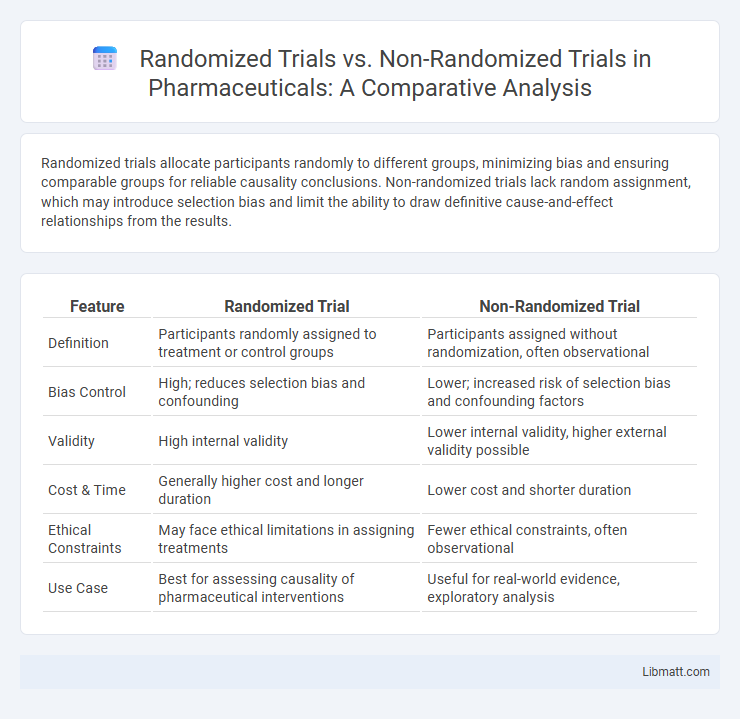Randomized trials allocate participants randomly to different groups, minimizing bias and ensuring comparable groups for reliable causality conclusions. Non-randomized trials lack random assignment, which may introduce selection bias and limit the ability to draw definitive cause-and-effect relationships from the results.
Table of Comparison
| Feature | Randomized Trial | Non-Randomized Trial |
|---|---|---|
| Definition | Participants randomly assigned to treatment or control groups | Participants assigned without randomization, often observational |
| Bias Control | High; reduces selection bias and confounding | Lower; increased risk of selection bias and confounding factors |
| Validity | High internal validity | Lower internal validity, higher external validity possible |
| Cost & Time | Generally higher cost and longer duration | Lower cost and shorter duration |
| Ethical Constraints | May face ethical limitations in assigning treatments | Fewer ethical constraints, often observational |
| Use Case | Best for assessing causality of pharmaceutical interventions | Useful for real-world evidence, exploratory analysis |
Introduction to Clinical Trials
Clinical trials are research studies designed to evaluate the safety and efficacy of medical interventions, with randomized trials randomly assigning participants to treatment or control groups to minimize bias. Non-randomized trials allocate participants based on non-random criteria, which can introduce selection bias and confounding variables. Randomized controlled trials (RCTs) are considered the gold standard in clinical research due to their ability to provide high-quality evidence for treatment effects.
Defining Randomized Trials
Randomized trials are research studies where participants are randomly assigned to different groups to receive specific interventions, ensuring unbiased distribution of variables. This random assignment is crucial for minimizing selection bias and increasing the reliability of causal inferences. Your understanding of randomized trials helps differentiate them from non-randomized trials, which lack this random allocation and are more susceptible to confounding factors.
Understanding Non-Randomized Trials
Non-randomized trials lack random assignment, often relying on observational or quasi-experimental designs, which can introduce selection bias and confounding variables that affect the validity of outcomes. These trials are useful when randomization is impractical or unethical, enabling researchers to study interventions in real-world settings while employing statistical methods like propensity score matching to mitigate bias. Understanding non-randomized trials helps you critically evaluate evidence quality and interpret findings within the context of potential limitations and strengths.
Key Differences Between Randomized and Non-Randomized Trials
Randomized trials allocate participants to treatment or control groups through randomization, minimizing selection bias and enhancing the reliability of causal inferences. Non-randomized trials assign treatments based on predetermined criteria or participant choice, which may introduce confounding factors that affect the outcome. Understanding these methodological differences helps you evaluate the strength of evidence and potential biases in clinical research.
Advantages of Randomized Trials
Randomized trials offer significant advantages by minimizing bias through random allocation, ensuring each participant has an equal chance of receiving the intervention. This method enhances the internal validity and reliability of results, making conclusions about causality more robust. Your confidence in treatment effectiveness increases due to the controlled and systematic approach of randomized trials compared to non-randomized designs.
Limitations of Randomized Trials
Randomized trials, while considered the gold standard for establishing causality, face limitations such as high costs, ethical constraints, and limited generalizability due to strict inclusion criteria. They often struggle with external validity, as results may not apply to broader, more diverse populations outside the controlled settings. Additionally, randomized trials can suffer from loss to follow-up and non-compliance, which may introduce bias and affect the reliability of outcomes.
Strengths of Non-Randomized Trials
Non-randomized trials offer valuable insights by enabling research in real-world settings where randomization is impractical or unethical, such as in observational studies of rare diseases or emergency treatments. They provide greater flexibility in study design, allowing evaluation of interventions across diverse populations and settings, which enhances external validity and applicability. Your ability to gather preliminary data or identify potential causal relationships often benefits from the pragmatic nature and lower cost of non-randomized trials compared to randomized controlled trials.
Weaknesses of Non-Randomized Trials
Non-randomized trials often suffer from selection bias and confounding variables, which can compromise the validity of their results. Without random assignment, groups may differ systematically, making it difficult to attribute outcomes directly to the intervention. Your interpretation of findings from non-randomized trials should consider these limitations to avoid overestimating treatment effects.
When to Choose Randomized vs. Non-Randomized Trials
Randomized trials are preferable when aiming to minimize bias and achieve high internal validity, especially in clinical research where causality between interventions and outcomes must be clearly established. Non-randomized trials are useful in settings with ethical, practical, or logistical limitations that prevent random assignment, such as observational studies or exploratory research. Choosing between these designs depends on the study's objectives, resources, and the feasibility of randomization to ensure reliable and applicable results.
Conclusion and Future Perspectives
Randomized trials provide robust evidence by minimizing selection bias and confounding factors, making their conclusions more reliable for clinical decision-making. Non-randomized trials, while valuable for hypothesis generation and studying real-world settings, often require cautious interpretation due to inherent biases and limited control over variables. Future research should emphasize hybrid designs and advanced statistical methods to enhance the validity of non-randomized studies, expanding their applicability alongside randomized controlled trials.
Randomized trial vs non-randomized trial Infographic

 libmatt.com
libmatt.com